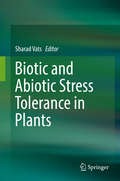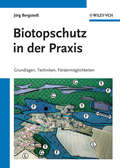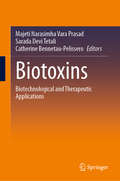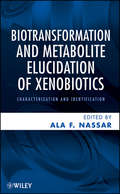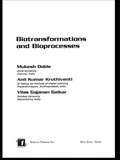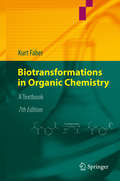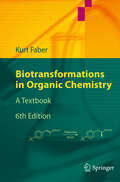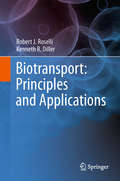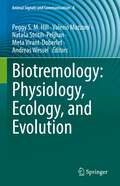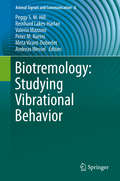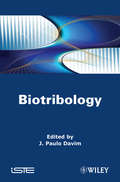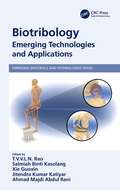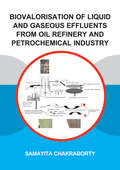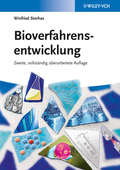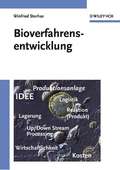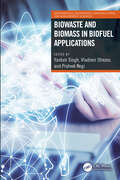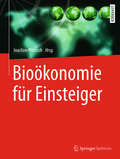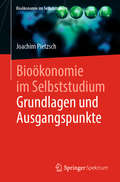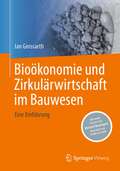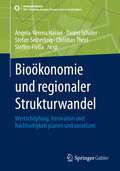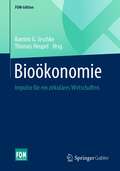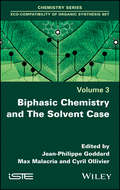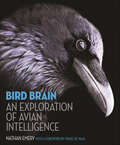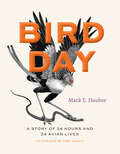- Table View
- List View
Biotic and Abiotic Stress Tolerance in Plants
by Sharad VatsThis book highlights some of the most important biochemical, physiological and molecular aspects of plant stress, together with the latest updates. It is divided into 14 chapters, written by eminent experts from around the globe and highlighting the effects of plant stress (biotic and abiotic) on the photosynthetic apparatus, metabolites, programmed cell death, germination etc. In turn, the role of beneficial elements, glutathione-S-transferase, phosphite and nitric oxide in the adaptive response of plants under stress and as a stimulator of better plant performance is also discussed. A dedicated chapter addresses research advances in connection with Capsicum, a commercially important plant, and stress tolerance, from classical breeding to the recent use of large-scale transcriptome and genome sequencing technologies. The book also explores the significance of the liliputians of the plant kingdom (Bryophytes) as biomonitors/bioindicators, and general and specialized bioinformatics resources that can benefit anyone working in the field of plant stress biology. Given the information compiled here, the book will offer a valuable guide for students and researchers of plant molecular biology and stress physiology alike.
Biotopschutz in der Praxis: Grundlagen -Techniken - Fordermoglichkeiten - Grundlagen - Planung - Handlungsmöglichkeiten
by Jörg BergstedtWer Biotope wirksam schützen will, muss deren Funktion verstehen. Auch wenn der der hohe Wert von natürlichen Lebensräumen für das ökologische Gleichgewicht der Erde lange bekannt ist, hat es die Natur nach wie vor schwer, sich angesichts des immer größeren Flächenverbrauchs durch den Menschen zu behaupten. Doch mit dem richtigen Handwerkszeug können intakte Biotope selbst dort entstehen, wo man sie kaum vermutet: am Rande von intensiv genutzten Ackerflächen, auf Abraumhalden oder mitten in der Großstadt. Dieser Ratgeber enthält das nötige Hintergrundwissen für den Schutz und die Neuanlage von Biotopen. Er zeigt, worauf es wirklich ankommt - von den ökologischen Grundlagen bis hin zu konkreten Schutzmaßnahmen und bestehenden Fördermöglichkeiten. Rund 30 der wichtigsten Lebensräume werden vorgestellt und ihre Bedeutung für das ökologische Landschaftsgefüge erklärt. Zahlreiche Schemata und Beispielbilder veranschaulichen die konkreten Maßnahmen für den praktischen Biotopschutz, ohne die Komplexität der Ökosysteme dabei auszublenden. Alles was man zum Schutz und bei der Neuanlage von Biotopen wissen muss. Ideal für Unterricht, Jugendarbeit und für alle Praktiker im Biotopschutz. Weiteres Material finden Sie unter www.biotopschutz.de.vu
Biotoxins: Biotechnological and Therapeutic Applications
by Majeti Narasimha Vara Prasad Sarada Devi Tetali Catherine Bennetau-PelisseroThis book covers biologically produced toxins, their chemistry, mode of action, and potential therapeutic applications. In the first part of the book, readers are introduced to the fundamental chemistry of biotoxins, their mechanisms of action, and possible antidotes, paving the way for a deeper understanding of their therapeutic potential. Subsequent chapters outline different types of biotoxins and their impact on food quality and safety, and their potential applications in agriculture and medicine. Particular attention is given to terrestrial and aquatic phytotoxins, bioactive metabolites produced by microorganisms and plants, mycotoxins, phycotoxins, cyanotoxins, neurotoxins of natural origin, bacterial toxins, insect toxins and marine toxins. An authoritative perspective on topics like bioterrorism and the military potential of biological toxins is also offered in this book. The second part of the book presents an overview of cutting-edge detection techniques to identify emerging biotoxins in several matrices. Readers will find an authoritative overview of the recent developments in nanotechnology and microfluidics (nanomaterial-based systems), and biosensors (immunosensors, receptor-based biosensors, and cell-based biosensors). The book also covers other detection techniques applied to food such as fluorescent, colourimetric, electrochemical, photoelectrochemical, and electrochemiluminescent techniques. Given its breadth, the book appeals to researchers, academics, and students interested in biotoxins, their pharmacological importance and their impact on agriculture and human health.
Biotransformation and Metabolite Elucidation of Xenobiotics
by Ala F. NassarThe goal of this book is to improve the readers' knowledge of metabolite elucidation in drug metabolism by exposing them to in depth coverage of the biotransformation of xenobiotics, strategies for identifying and characterizing metabolites, FDA guidelines, and case studies on how to improve the decision-making process in structural modification of drug candidates to reduce toxicity.The book consists of 8 chapters; it first provides an introduction on biotransformation of xenobiotics, and then presents modern approaches and strategies for dealing with metabolite characterization, using tools such as LC-MS, H-D exchange, stable isotopes LC-MS-NMR, and radiolabeled compounds. Also, strategies for dealing with reactive intermediates in drug discovery and development are presented as well as case studies on improving the decision-making process in the structural modification of drug candidates. The last chapter discusses the regulatory perspectives of safety testing of drug metabolites and why, how, and when to test their safety.
Biotransformations and Bioprocesses (Biotechnology And Bioprocessing Ser. #Vol. 28)
by Mukesh Doble Anil Kumar Kruthiventi Vilas Gajanan GaikarFrom the laboratory to full-scale commercial production, this reference provides a clear and in-depth analysis of bioreactor design and operation and encompasses critical aspects of the biocatalytic manufacturing process. It clarifies principles in reaction and biochemical engineering, synthetic and biotransformation chemistry, and biocell and enzy
Biotransformations in Organic Chemistry: A Textbook
by Kurt FaberThe use of natural catalysts - enzymes - for the transformation of non-natural is not at all new: they have been used for more man-made organic compounds than one hundred years, employed either as whole cells, cell organelles or isolated enzymes [1]. Certainly, the object of most of the early research was totally different from that of the present day. Thus the elucidation of biochemical pathways and enzyme mechanisms was in the foreground of the reasearch some decades ago. It was mainly during the 1980s that the enormous potential of applying natural catalysts to transform non-natural organic compounds was recognized. What started as a trend in the late 1970s could almost be called a fashion in synthetic organic chemistry in the 1990s. Although the early euphoria during the 'gold rush' in this field seems to have eased somewhat, there is still no limit to be seen for the future development of such methods. As a result of this extensive, recent research, there have been an estimated 5000 papers published on the subject [2]. To collate these data as a kind of 'super-review' would clearly be an impossible task and, furthermore, such a hypothetical book would be unpalatable for the non-expert.
Biotransformations in Organic Chemistry: A Textbook
by Kurt FaberThe use of biocatalysts, employed either as isolated enzymes or whole microbial cells, offers a remarkable arsenal of highly selective transformations for state-of-the-art synthetic organic chemistry. Over the last two decades, this methodology has become an indispensable tool for asymmetric synthesis, not only at the academic level, but also on an industrial scale. This well-established textbook on biocatalysis provides a basis for undergraduate and graduate courses in modern organic chemistry, as well as a condensed introduction into this field. After a basic introduction into the use of biocatalysts--principles of stereoselective transformations, enzyme properties and kinetics--the different types of reactions are explained according to the 'reaction principle', such as hydrolysis, reduction, oxidation, C-C bond formation, etc. Special techniques, such as the use of enzymes in organic solvents, immobilization techniques and modified or artificial enzymes, are treated in a separate section. A final chapter deals with thebasic rules for the safe and practical handling of biocatalysts. In this completely revised 6th edition, emphasis has been given to an improved didactic style including colored graphics in order to facilitate a deeper understanding of the underlying principles. New developments, such as transamination, enzyme promiscuity and applications on industrial scale within the field of 'white biotechnology' are included.
Biotransport: Principles And Applications
by Robert J. Roselli Kenneth R. DillerIntroduction to Biotransport Principles is a concise text covering the fundamentals of biotransport, including biological applications of: fluid, heat, and mass transport.
Biotremology: Physiology, Ecology, and Evolution (Animal Signals and Communication #8)
by Andreas Wessel Peggy S. M. Hill Valerio Mazzoni Meta Virant-Doberlet Nataša Stritih-PeljhanBiotremology is a new and emerging discipline in biological sciences that covers all aspects of behavior associated with substrate-borne mechanical waves. This volume provides state-of-the-art reviews and technical contributions from leading experts and invited younger researchers on topics from signal production and transmission to perception in its ecological context. Reviews about the knowledge of well-studied groups are complemented with perspectives on the study of less-explored groups or contexts. Special attention is given to practical issues in measuring substrate-borne vibrations as well as to applied biotremology. The book appeals to all those interested in communication and vibrational behavior.
Biotremology: Studying Vibrational Behavior (Animal Signals and Communication #6)
by Andreas Wessel Peggy S. M. Hill Reinhard Lakes-Harlan Valerio Mazzoni Peter M. Narins Meta Virant-DoberletThis volume is a self-contained companion piece to Studying Vibrational Communication, published in 2014 within the same series. The field has expanded considerably since then, and has even acquired a name of its own: biotremology. In this context, the book reports on new concepts in this fascinating discipline, and features chapters on state-of-the art methods for studying behavior tied to substrate-borne vibrations, as well as an entire section on applied biotremology. Also included are a historical contribution by pioneers in the field and several chapters reviewing the advances that have been made regarding specific animal taxa. Other new topics covered are vibrational communication in vertebrates, multimodal communication, and biotremology in the classroom, as well as in art and music. Given its scope, the book will appeal to all those interested in communication and vibrational behavior, but also to those seeking to learn about an ancient mode of communication.
Biotribology
by J. Paulo DavimTribology is the “science and technology of interacting surfaces in relative motion” and encompasses the study of friction, wear and lubrication. By extension biotribology is usually defined as the tribological phenomena occurring in either the human body or in animals. Therefore, it is possible to consider tribological processes that may occur after implantation of an artificial device in the human body and the tribological processes naturally occurring in or on the tissues and organ of animals. Animals, including humans, possess a wide variety of sliding and frictional interfaces. The authors aim to provide some advances in research in biotribology. They cover several aspects of biotribology such as tribology of synovial joints and artificial replacements; wear of screws and plates in bone fractures repair; wear of denture and restorative materials; friction of the skin and comfort of clothing; wear of replacement heart valves; tribology of contact lenses and ocular tribology; biotribology on the microscale and nanoscale levels, etc. This book can be used as a research text for final undergraduate engineering courses (for example, materials, biomedical, etc.) or for those studying the subject of biotribology at the postgraduate level. It can also serve as a useful reference for academics, biomechanical researchers, biologists, chemists, physicists, biomedicals and materials engineers, and other professionals in related engineering, medicine and biomedical industries.
Biotribology: Emerging Technologies and Applications (Emerging Materials and Technologies)
by Jitendra Kumar Katiyar Salmiah Binti Kasolang T.V.V.L.N. Rao Ahmad Majdi Abdul Rani Xie GuoxinBiotribology includes tribological phenomena of natural and implant surface interactions under relative motion in the human body. Biotribology: Emerging Technologies and Applications disseminates ideas and research trends in biotribology and presents pioneering recent research advances impacting the field, focusing on the roles of mathematics, chemistry, physics, materials, and mechanical engineering. Discusses lubrication of joint replacements, computational modeling of biotribology and multibody biomechanical models Describes metal-organic frameworks, medical friction pairs, and electrochemical techniques to tribocorrosion tests Covers state of the art and future technological developments and applications, as well as challenges and opportunities Biotribology is an important and growing field, and the topics covered in this book will be of great interest to the international tribology community, appealing to readers working in the fields of materials science, biomedical engineering, biotechnology, mechanical engineering, and related areas.
Biovalorisation of Liquid and Gaseous Effluents of Oil Refinery and Petrochemical Industry (IHE Delft PhD Thesis Series)
by Samayita ChakrabortyA bidirectional approach of detoxifying the liquid and gaseous effluents of oil refineries is elucidated in this thesis. Liquid effluents of oil refineries contain selenium oxyanions and phenol, while gaseous effluents contain CO/syngas. To remove the phenol and simultaneously reduce the selenite oxyanions, a fungal-bacterial co-culture of Phanerochaete chrysosporium and Delftia lacustris was developed. Two modes of co-cultures of the fungus and the bacterium were developed. Both cultures were investigated for phenol degradation and selenite reduction. In order to valorize the CO/syngas by bioconversion techniques. an anaerobic methanogenic sludge was acclimatized to use CO as the sole carbon substrate to produce acetic acid, butyric acid, and hexanoic acid. Later, the acids were metabolized at lower pH, producing alcohols ethanol, butanol and hexanol, confirming the successful enrichment strategy. The next experiment focused on the absence of the trace element tungsten, and consecutively selenium on the previously CO acclimatized sludge under the same operating conditions. An in-situ synthesized co-polymeric gel of N-ter-butyl-acrylamide and acrylic acid was used to recover ethanol, propanol and butanol from a synthetic fermentation broth. The scope of repeated use of the gel for alcohol recovery was investigated and 98% alcohol was recovered.
Bioverfahrensentwicklung: Praxisbeispiele Für Auslegung, Betrieb Und Kostenanalyse
by Winfried StorhasZukunft sichern durch Nachhaltigkeit? Bioverfahrenstechnik bedeutet einen wichtigen Schritt auf dem Weg dorthin. Sie ersetzt klassische chemische Syntheseverfahren durch nachhaltige biologische Verfahren und vereint unterschiedliche Gebiete aus dem naturwissenschaftlichen und ingenieurtechnischen Bereich. Mit diesem Buch wird allen, die an der Entwicklung biotechnologischer Prozesse beteiligt sind, ein Werk an die Hand gegeben, das die einzelnen Aspekte der Bioverfahrensentwicklung darstellt und zu einem Gesamtbild zusammenfugt: Mikrobiologie, Molekularbiologie, Zellbiologie und Biochemie sowie die ingenieurtechnischen Bereiche Elektrotechnik, Informatik, Steuerungstechnik, Maschinenbau und Verfahrenstechnik - jeweils aus dem Blickwinkel der Verfahrensentwicklung betrachtet. Mit klaren, praxisorientierten Verfahrensbeispielen werden die beschriebenen Prozesse erklart. Im Vordergrund stehen dabei Verfahren, die in der Industrie eine wichtige Rolle spielen. Wirtschaftlichkeitsbetrachtungen, die bei der Entwicklung eines Verfahrens schon im Anfangsstadium eine entscheidende Rolle spielen, ist ein ganzes Kapitel gewidmet. Die zweite Auflage des Erfolgstitels von 2003 ist ein Muss fur alle Studenten der Biotechnologie und Verfahrenstechnik und das ideale Nachschlagewerk fur Ingenieure der Verfahrenstechnik, Biochemiker und Pharmazeuten. Stimmen zur 1. Auflage: 'Das Buch ist ein nutzlicher Begleiter in der taglichen Praxis und kann sowohl als Lehrbuch wie auch als Nachschlagewerk verwendet werden.' BIO WORLD, Dr. C. Andretta 'Dieses Buch richtet sich an alle, die einen Beitrag zur Entwicklung eines biotechnologischen Prozesses leisten mochten. Es informiert sehr ausfuhrlich uber die Bioverfahrensentwicklung und ermoglicht, sich ein Gesamtbild zu verschaffen. Es ist auch als Lehrbuch fur das Gebiet Bioverfahrenstechnik gut geeignet.' F & S (Filtrieren und Separieren)
Bioverfahrensentwicklung: Praxisbeispiele Für Auslegung, Betrieb Und Kostenanalyse
by Winfried StorhasBioverfahren haben sich in vielen Bereichen als überlegene Alternativen zu klassischen Produktionsverfahren etabliert, und ihre Bandbreite wird immer größer. Die Biotechnologie, insbesondere unter Einbezug der Gentechnik, hat zweifellos Zukunft. Die schnelle und effiziente Umsetzung von Forschungsergebnissen in wirtschaftliche Anwendungen birgt ein enormes wirtschaftliches Potential - und kaum eine andere Branche wächst derzeit so schnell wie die Biotechnologie. Wo sonst gibt es so viele Firmenneugründungen? Doch wie schafft man es, sich schnell zu orientieren? Das vorliegende Buch gibt einen Überblick über die systematische Entwicklung von Bioverfahren. Einer Zusammenstellung der unterschiedlichen Varianten der einzelnen Verfahrensschritte folgen die Beschreibung integrierter Gesamtprozesse, Wirtschaftlichkeitsbetrachtungen und Verfahrensbeispiele. Im Vordergrund stehen dabei Verfahren, die bereits eine wichtige Rolle in der Industrie spielen. Biotechnologie bedeutet Zukunftstechnologie!
Biowaste and Biomass in Biofuel Applications (Mathematical Engineering, Manufacturing, and Management Sciences)
by Vladimir Strezov Yashvir Singh Prateek NegiThis book reflects the new dimension of biofuel production from its introductory principles to the advancements from a future prospective. It summarizes the rationale for changes in liquid fuel utilization and the selection of new technologies to make biofuel cost-effective and move toward a carbon-neutral approach. It provides an evidence-based outline of how additives and nanotechnology chemically change biofuels' quality and effectiveness, including new and innovative approaches, such as nanomaterials and various nano-additives. Features: It provides an overview of biowaste as a sustainable source in the field of biofuel production It includes effective conversion parameters of the biowaste feedstocks and their classification It summarizes current research into the development and exploitation of new biofuel sources It discusses the improvement of pilot scale scalability, chemical processing, and design flow It presents relevant and realistic global explanations of biowaste management techniques for biofuels This book is aimed at senior undergraduate and graduate students, and researchers in bioprocessing, chemical engineering, and biotechnology.
Bioökonomie für Einsteiger
by Stephan Meyer Joachim Pietzsch Wolfgang Zettlmeier Ulrich SchurrDieses Buch bietet eine aktuelle und gut lesbare Einführung in die Bioökonomie. Es vermittelt damit grundlegende Kenntnisse zum Verständnis eines Transformationsprozesses, der das 21. Jahrhundert prägen wird und die Integration vieler Disziplinen und Branchen verlangt, die bisher wenig miteinander zu tun hatten. Die Rede ist von dem allmählichen und notwendigen Übergang aus dem Zeitalter fossiler Brennstoffe, das vor rund 200 Jahren begann, in eine weltweite Wirtschaftsform, die auf nachwachsenden Rohstoffen (und erneuerbaren Energien) basiert. Dieses Buch begreift die Verwirklichung von Bioökonomie(n) dabei als eine dreifache Herausforderung – eine naturwissenschaftliche, eine ökonomische und eine ökologische. Woher stammt die Biomasse, die wir vorrangig für die Ernährung der wachsenden Weltbevölkerung wie auch für eine zukünftige energetische und stoffliche Nutzung brauchen? Wie wird sie in Bioraffinerien verarbeitet und welche Rolle kommt der Biotechnologie zu? Welche Gesichtspunkte der Innovationsökonomie gilt es zu bedenken, welche betriebswirtschaftlichen Aspekte der Wertschöpfung, Wettbewerbsfähigkeit und Kundenakzeptanz sind von Bedeutung? Welche Bedingungen muss die Bioökonomie erfüllen, um eine nachhaltige Entwicklung der Erde zu ermöglichen? Darf sie überhaupt auf Wachstumsziele setzen oder sollte sie sich nicht besser am Ideal der Suffizienz orientieren? Indem das Buch diese Fragen aus den nicht widerspruchsfreien Perspektiven ausgewiesener Experten behandelt, gibt es einen interdisziplinären Überblick über ein dynamisches Feld von Forschung und Praxis, der mehr Fragen aufwirft als beantwortet und dennoch eine Lücke schließt. Denn bisher gibt es keine verständliche und fachübergreifende Darstellung der Bioökonomie. Das macht die Lektüre dieses Buches zu einem Gewinn nicht nur für Einsteiger, sondern auch für Fachleute, die über die Grenzen ihres eigenen Fachgebietes hinausschauen wollen.
Bioökonomie im Selbststudium: Grundlagen und Ausgangspunkte (Zertifikatskurs Bioökonomie)
by Joachim PietzschDieses Studienheft ist ein Teil des Springer Zertikfikatskurses Bioökonomie und wird als Material zum Selbstlernen eingesetzt.Historische Einordnung | Entstehung des Begriffs Bioökonomie | Verschiedene politische Strategien der Bioökonomie| Bioökonomie und Nachhaltigkeit | Kaskadennutzung und Kreislaufwirtschaft| Profilierte Bioökonomie-Regionen in Deutschland | Gesetzliche Rahmenbedingungen | Die sieben Herausforderungen der Bioökonomie | Vorstellung beispielhafter Produkte | Fallstudien
Bioökonomie und Zirkulärwirtschaft im Bauwesen: Eine Einführung
by Jan GrossarthDas Bauwesen sucht neue Wege. Ein intelligenterer Umgang mit Materialien wie Ziegeln, Stahl, Beton oder Holz ist notwendig. Techniken und Konzepte dafür gibt es. Aber die Umsetzung bleibt träge. Die Gründe dafür sind nicht allein technischer und ökonomischer Art. Auch die sozial- und kulturwissenschaftliche Perspektive auf Akteure, Institutionen und ökologische Krisenwahrnehmungen ist aufschlussreich.Wie lässt sich ein auf Ressourcenbewahrung und Klimaschutz ausgerichteter Bau verwirklichen? Welche Beiträge leisten Zertifizierungen, Ökobilanzierung und die Kommunikation? Was ist von innovativen Zementen oder Recycling-Baustoffen zu erwarten? Und von Nachwachsenden Rohstoffen wie Holz oder Stroh? Welche Beiträge können der politische Ordnungsrahmen und die Werte nachhaltiger Architektur - Ästhetik, Charakter, Geschichtlichkeit - leisten? Wie sind Ziel- und Interessenkonflikte zu beschreiben? Der Ansatz der Bioökonomie verbindet die Idee zirkulärer Stoffströme mit ökonomischem Realitätssinn. Dieses Buch gibt einen Überblick, der von historischen Vorbildern bis zu biotechnologischen Innovationen reicht. Es führt erstmals Ansätze der Bioökonomie und Zirkulärwirtschaft mit der Nachhaltigkeitsausrichtung des Bauwesens zusammen und ordnet sie in handlungsrelevante Kontexte ein. Mit mehreren Exkursionen, und Experteninterviews mit Armin Grunwald und vielen anderen. Sowie einem Vorwort von Michael Braungart: „Unsere Nachhaltigkeits-Expertokratie hilft, das Verkehrte zu optimieren. Zugleich gibt es aber auch gute Entwicklungen.“Das Buch richtet sich an Leserinnen und Leser aus den Bereichen Bauingenieurwesen, Baupraxis, Architektur, Immobilien, Bioökonomie, sowie an Studierende, interessierte Laien und an Akteure der Politik und Politikberatung.
Bioökonomie und regionaler Strukturwandel: Wertschöpfung, Innovation und Nachhaltigkeit planen und umsetzen (SDG - Forschung, Konzepte, Lösungsansätze zur Nachhaltigkeit)
by Steffen Fleßa Daniel Schiller Angela-Verena Hassel Stefan Seiberling Christian TheelBioökonomie ist eine neue branchenübergreifende Form des Wirtschaftens, die das Potenzial hat, die bisherige Ökonomie und einzelne Regionen grundlegend zu verändern. Dieser Überzeugung folgend stellen die Herausgeber und Autoren dieses Buches den aktuellen Wissenstand aus Theorie und Praxis der Bioökonomie zusammen, entwickeln neue Methoden für einen bioökonomischen Strukturwandel und reflektieren bestehende Bioökonomiekonzepte. Der komplexe und vielschichtige Prozess einer pflanzenbasierten Bioökonomie in ländlichen Räumen wird aus unterschiedlichen Perspektiven betrachtet. Zunächst werden ökonomische Grundlagen sowohl aus gesamt- als auch aus einzelwirtschaftlicher Sicht diskutiert. Dem schließen sich Beispiele an, wie regionale Innovationsnetzwerke und Wertschöpfungsketten der Bioökonomie einen Beitrag zur nachhaltigen Regionalentwicklung und zum gesellschaftlichen Wandel leisten können. Die darauf aufbauende Analyse legt dar, wie verschiedene Akteure und Prozesse eine regionale Bioökonomie in der Praxis etablieren können. Ausgewählte Anwendungs- und Umsetzungsbeispiele für Innovationen pflanzenbasierter Bioökonomie im nordöstlichen Mecklenburg-Vorpommern runden das Buch ab und zeigen das Potenzial für eine Transformation der Wirtschaft in der Region und darüber hinaus.
Bioökonomie: Impulse für ein zirkuläres Wirtschaften (FOM-Edition)
by Thomas Heupel Barnim G. JeschkeIn der Definition der Bundesregierung umfasst die Bioökonomie die „Erzeugung, Erschließung und Nutzung biologischer Ressourcen, Prozesse und Systeme, um Produkte, Verfahren und Dienstleistungen in allen wirtschaftlichen Sektoren im Rahmen eines zukunftsfähigen Wirtschaftssystems bereitzustellen“. Viele Publikationen adressieren stark die technologischen Facetten der Bioökonomie. In dem vorliegenden Sammelband werden hingegen Anwendungsaspekte, Potenziale und Hemmnisse aus wissenschaftlicher – aber eben auch aus betrieblicher – Sicht reflektiert, um konkrete Erkenntnisse für Geschäftsmodelle abzuleiten, die regenerative Rohstoffe in ihre Wertschöpfung einbeziehen. Die branchenbezogenen Erkenntnisse münden in einen Leitfaden, der Aufschluss über den bioökonomischen Reifegrad des jeweiligen Unternehmens gibt.
Biphasic Chemistry and The Solvent Case
by Jean-Philippe Goddard Max Malacria Cyril OllivierBiphasic Chemistry and The Solvent Case examines recent improvements in reaction conditions, in order to affirm the role of chemistry in the sustainable field. This book shows that those who work within the chemistry industry support limits for the use of toxic or flammable solvents, since it reduces the purifications to simple filtrations. Thanks to commercial scavengers, solid phase syntheses are now available to all. Fluorine biphasic catalysis enables extremely efficient catalyst recycling and has a high applicability potential at the industrial level. This book also reviews the many studies that have shown that water is a solvent of choice for most synthetic reactions. Particular traits can be obtained and the effects on thermodynamics make it possible to operate at lower temperatures, thereby achieving energy savings. Finally the great diversity of application of the reactions without solvents is illustrated.
Bird Brain: An Exploration of Avian Intelligence
by Nathan EmeryWhy birds are smarter than we thinkBirds have not been known for their high IQs, which is why a person of questionable intelligence is sometimes called a "birdbrain." Yet in the past two decades, the study of avian intelligence has witnessed dramatic advances. From a time when birds were seen as simple instinct machines responding only to stimuli in their external worlds, we now know that some birds have complex internal worlds as well. This beautifully illustrated book provides an engaging exploration of the avian mind, revealing how science is exploding one of the most widespread myths about our feathered friends—and changing the way we think about intelligence in other animals as well.Bird Brain looks at the structures and functions of the avian brain, and describes the extraordinary behaviors that different types of avian intelligence give rise to. It offers insights into crows, jays, magpies, and other corvids—the “masterminds” of the avian world—as well as parrots and some less-studied species from around the world. This lively and accessible book shows how birds have sophisticated brains with abilities previously thought to be uniquely human, such as mental time travel, self-recognition, empathy, problem solving, imagination, and insight.Written by a leading expert and featuring a foreword by Frans de Waal, renowned for his work on animal intelligence, Bird Brain shines critical new light on the mental lives of birds.
Bird Day: A Story of 24 Hours and 24 Avian Lives (Earth Day Ser.)
by Mark E. HauberAn hourly guide that follows twenty-four birds as they find food, mates, and safety from predators. From morning to night and from the Antarctic to the equator, birds have busy days. In this short book, ornithologist Mark E. Hauber shows readers exactly how birds spend their time. Each chapter covers a single bird during a single hour, highlighting twenty-four different bird species from around the globe, from the tropics through the temperate zones to the polar regions. We encounter owls and nightjars hunting at night and kiwis and petrels finding their way in the dark. As the sun rises, we witness the beautiful songs of the “dawn chorus.” At eleven o’clock in the morning, we float alongside a common pochard, a duck resting with one eye open to avoid predators. At eight that evening, we spot a hawk swallowing bats whole, gorging on up to fifteen in rapid succession before retreating into the darkness. For each chapter, award-winning artist Tony Angell has depicted these scenes with his signature pen and ink illustrations, which grow increasingly light and then dark as our bird day passes. Working closely together to narrate and illustrate these unique moments in time, Hauber and Angell have created an engaging read that is a perfect way to spend an hour or two—and a true gift for readers, amateur scientists, and birdwatchers.
Bird Day: A Story of 24 Hours and 24 Avian Lives (Earth Day)
by Mark E. HauberAn hourly guide that follows twenty-four birds as they find food, mates, and safety from predators. From morning to night and from the Antarctic to the equator, birds have busy days. In this short book, ornithologist Mark E. Hauber shows readers exactly how birds spend their time. Each chapter covers a single bird during a single hour, highlighting twenty-four different bird species from around the globe, from the tropics through the temperate zones to the polar regions. We encounter owls and nightjars hunting at night and kiwis and petrels finding their way in the dark. As the sun rises, we witness the beautiful songs of the “dawn chorus.” At eleven o’clock in the morning, we float alongside a common pochard, a duck resting with one eye open to avoid predators. At eight that evening, we spot a hawk swallowing bats whole, gorging on up to fifteen in rapid succession before retreating into the darkness. For each chapter, award-winning artist Tony Angell has depicted these scenes with his signature pen and ink illustrations, which grow increasingly light and then dark as our bird day passes. Working closely together to narrate and illustrate these unique moments in time, Hauber and Angell have created an engaging read that is a perfect way to spend an hour or two—and a true gift for readers, amateur scientists, and birdwatchers.
